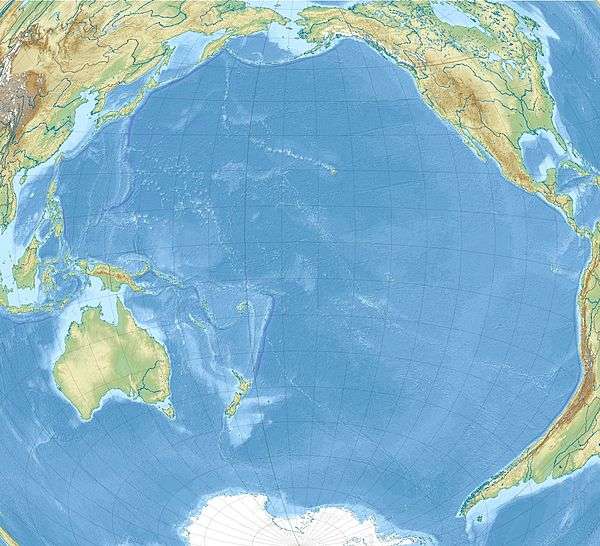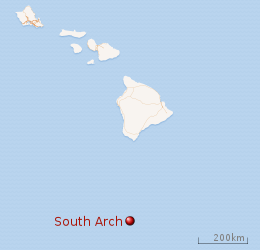South Arch volcanic field
South Arch volcanic field is an underwater volcanic field south of Hawaiʻi Island. It was active during the last 10,000 years, and covers an area of 35 by 50 kilometres (22 mi × 31 mi) at a depth of 4,950 metres (16,240 ft).
| South Arch volcanic field | |
|---|---|
 South Arch volcanic field 200 kilometres (120 mi) south from Hawaiʻi Island | |
| Highest point | |
| Elevation | 10 m (33 ft) |
| Coordinates | 17°15′N 155°45′W [1] |
| Dimensions | |
| Length | 35 km (22 mi) |
| Width | 50 km (31 mi) |
| Geography | |
| Location | 200 kilometres (120 mi) south from Hawaiʻi Island |
| Country | United States |
| State | Hawaii |
| Geology | |
| Mountain type | Volcanic field |
| Type of rock | Basaltic rock |
 |
| Location south of the Hawaiian Islands |
Although the field is related to the Hawaiian hotspot, it does not appear to be a precursory volcano, but seems to have formed when the weight of the growing Hawaiian volcanoes caused the oceanic crust to buckle, opening up pathways for magma to ascend in front of the hotspot.
Geomorphology
The volcanic field lies about 200 kilometres (120 mi) south from Hawaiʻi Island,[1] at a depth of around 4,950 metres (16,240 ft) below sea level. It covers an area of 35 by 50 kilometres (22 mi × 31 mi).[2] It consists of[1] several metres thick[3] lava flows that are surrounded by sediment-covered seafloor mainly to the north and east and by clusters of[1] Cretaceous seamounts[2] mainly to the west and southwest.[1]
In sidescan sonar images, young lava flows have a bright appearance while older ones are covered by sediments and thus appear darker, and structures identified as lava coils, lava rubble, lava tumuli, pillow lavas, polygons and sheet flows have been observed on young flows. The lava flows have buried the pre-existent seafloor topography, smoothening it,[2] and in one place a flow front rises about 10 metres (33 ft) from the seafloor.[4] The lava flows erupted in the South Arch volcanic field were probably fluid and were produced at high rates.[5] There is no evidence for the presence of a magma chamber at the South Arch volcanic field.[6]
Geology
The volcanic field is located on the crest of the Hawaiian Arch, an area of Cretaceous seafloor around Hawaii which has buckled under the weight of the Hawaiian volcanoes, causing uplift and volcanic activity[1] where the crust has broken up, allowing magma to rise to the surface.[5] The presence of older seamounts in the area of the South Arch volcanic field may have influenced the onset of volcanism in the field.[5] Such eccentric volcanism has also been inferred at other hotspots.[7]
The South Arch volcanic field is not the only volcanic system on the Arch, there is also the[1] much larger[8] North Arch volcanic field north of Oahu and small lava flows at the foot of Pensacola Seamount southwest from Hawaiʻi Island.[1] Together these volcanic fields have a larger surface than the islands of Hawaii[2] and expand the area affected by Hawaiian volcanism to over 500 kilometres (310 mi) width;[5] they have been called "peripheral lavas" of the Hawaii hotspot.[9] The South Arch volcanic field is located upstream of the Hawaiian hotspot[10] and has been described as "precursory"[11] although it does not appear to be an early stage of a typical Hawaiian shield volcano.[3]
Composition
Dredging has yielded basaltic rocks which define alkali basalt and basanite suites. The flows contain phenocrysts of clinopyroxene, iddingsite, olivine, plagioclase and sometimes spinel.[4] Lava flows are covered by manganese crusts less than 0.15 millimetres (0.0059 in) thick.[12] They often display traces of alteration and formation of glasses such as palagonite. Some dredge samples might come from neighbouring Cretaceous seamounts rather than the South Arch volcanic field, however.[4]
The alkalic composition[5] of the lavas resembles that of rejuvenated stage volcanics on Kauai, that of preshield volcanics at Loihi[4] and that of the North Arch volcanic field;[13] they share with the latter a high ratio of helium-3/helium-4 and a high carbon dioxide content.[14] Mixing between mantle plume melts of the Hawaiian hotspot and components typical of mid-ocean ridge basalts may have given rise to the volcanics of the South Arch volcanic field,[15] with metasomatism involved as well.[16] The magmas of the South Arch volcanic field appear to have been unusually water-rich, perhaps because of an early melting of water-rich mantle.[17]
Eruption and research history
The field appears to consist of some central younger lava flows which are surrounded by older lava flow fields.[1] Based on the thickness of manganese, palagonite and sediment cover on lava flows, it appears that younger flows are 10,000–1,000 years old, while the older flows may be over 10,000–100,000 years old;[18] in general the thickness of manganese crusts is comparable to these found on Mauna Loa, Kilauea and Loihi rocks.[19] Another age range cited in the literature is 14,000–20,000 years ago.[20] It is possible that magma ascended to the surface mainly in areas where the lithosphere has anomalous properties and is more likely to crack rather than to flex; this would explain why the vents of the South Arch volcanic field coincide with Cretaceous seamounts.[21]
The South Arch volcanic field was discovered in 1986 through GLORIA sidescan sonar imaging and dredged in 1988.[1] Another investigation by the Kaikō remotely operated underwater vehicle took place in 2001;[22] in general the field has been explored by dredging, remotely operated underwater vehicle and submersible.[12]
References
- Holcomb et al. 1989, p. 611.
- Holcomb et al. 1989, p. 612.
- Hofmann, Albrecht W.; Farnetani, Cinzia G.; Spiegelman, Marc; Class, Cornelia (December 2011). "Displaced helium and carbon in the Hawaiian plume". Earth and Planetary Science Letters. 312 (1–2): 233. doi:10.1016/j.epsl.2011.09.041.
- Holcomb et al. 1989, p. 613.
- Holcomb et al. 1989, p. 614.
- Klügel, Andreas; Klein, Frieder (2006). "Complex magma storage and ascent at embryonic submarine volcanoes from the Madeira Archipelago". Geology. 34 (5): 337. Bibcode:2006Geo....34..337K. doi:10.1130/G22077.1 – via ResearchGate.
- Larson, R.L.; Lancelot, Y., eds. (December 1992). Proceedings of the Ocean Drilling Program, 129 Scientific Results. Proceedings of the Ocean Drilling Program. 129. Ocean Drilling Program. p. 349. doi:10.2973/odp.proc.sr.129.128.1992.
- Clague, David A.; Holcomb, Robin T.; Sinton, John M.; Detrick, Robert S.; Torresan, Michael E. (1 May 1990b). "Pliocene and Pleistocene alkalic flood basalts on the seafloor north of the Hawaiian islands". Earth and Planetary Science Letters. 98 (2): 176. doi:10.1016/0012-821X(90)90058-6. ISSN 0012-821X.
- Clague et al. 1990, p. 184.
- Clague & Dixon 2001, p. 629.
- Clague & Dixon 2001, p. 640.
- Clague & Moore 2004, p. 341.
- Clague et al. 1990, p. 181.
- Carey, Rebecca; Cayol, Valérie; Poland, Michael; Weis, Dominique (2015). Hawaiian Volcanoes: From Source to Surface. John Wiley & Sons. p. 8. ISBN 9781118872161.
- Kani, T.; Hanan, B. B.; Kingsley, R.; Schilling, J. (1 December 2005). "Constraints on the Source Components Involved in the Magmatism of North Arch Volcanic Field and South Arch Volcanic Field, Hawaii". AGU Fall Meeting Abstracts. 51: V51A–1470. Bibcode:2005AGUFM.V51A1470K.
- Clague & Dixon 2001, p. 645.
- Clague & Dixon 2001, p. 650.
- Holcomb et al. 1989, pp. 613-614.
- Clague & Moore 2004, p. 343.
- Sinton, J. M.; Mahoney, J. J.; Clague, D.; Frey, F. A. (1 May 2000). "Volcanism at the Edge of the Hawaiian Plume: Petrogenesis of Submarine Alkalic Lavas from the North Arch Volcanic Field". Journal of Petrology. 41 (5): 667. doi:10.1093/petrology/41.5.667. ISSN 0022-3530.
- Clague et al. 1990, p. 190.
- Hanyu, Takeshi; Clague, David A.; Kaneoka, Ichiro; Dunai, Tibor J.; Davies, Gareth R. (January 2005). "Noble gas systematics of submarine alkalic lavas near the Hawaiian hotspot". Chemical Geology. 214 (1–2): 135–155. doi:10.1016/j.chemgeo.2004.08.051.
Sources
- Clague, David A.; Holcomb, Robin T.; Sinton, John M.; Detrick, Robert S.; Torresan, Michael E. (May 1990). "Pliocene and Pleistocene alkalic flood basalts on the seafloor north of the Hawaiian islands". Earth and Planetary Science Letters. 98 (2): 175–191. doi:10.1016/0012-821X(90)90058-6.
- Clague, David A.; Dixon, Jacqueline Eaby (1 March 2001). "Volatiles in Basaltic Glasses from Loihi Seamount, Hawaii: Evidence for a Relatively Dry Plume Component". Journal of Petrology. 42 (3): 627–654. doi:10.1093/petrology/42.3.627. ISSN 0022-3530.
- Clague, David A.; Moore, James G. (2004-03-01). "Hawaiian submarine manganese-iron oxide crusts—A dating tool?". GSA Bulletin. 116 (3–4): 337–347. doi:10.1130/B25304.1. ISSN 0016-7606.
- Holcomb, Robin T.; Moore, James G.; Clague, David A.; Lipman, Peter W. (1 July 1989). "South Arch volcanic field—Newly identified young lava flows on the sea floor south of the Hawaiian Ridge". Geology. 17 (7): 611–614. doi:10.1130/0091-7613(1989)017<0611:SAVFNI>2.3.CO;2. ISSN 0091-7613.
